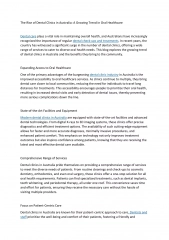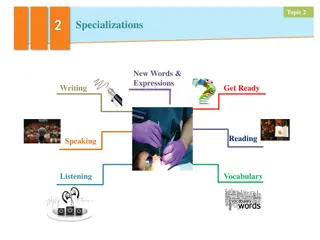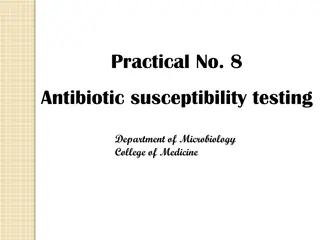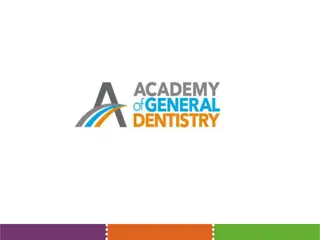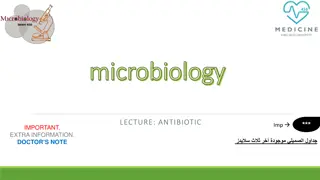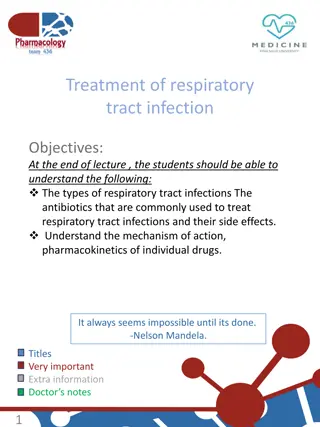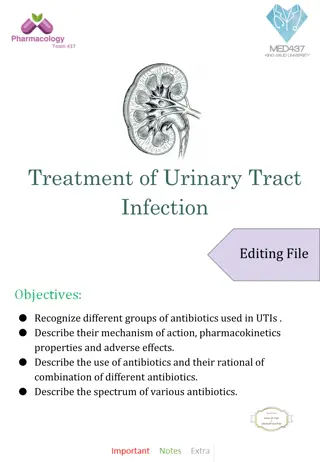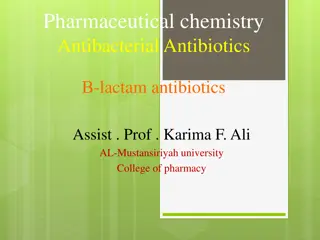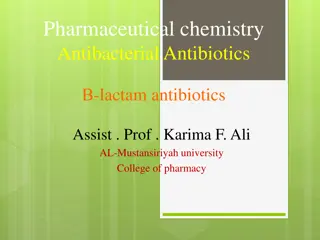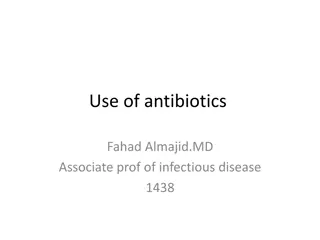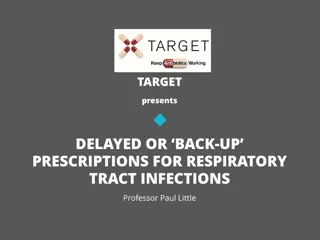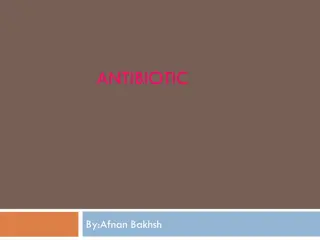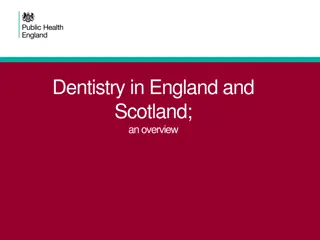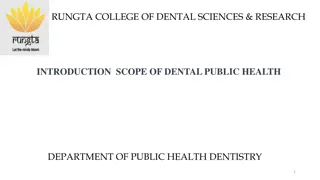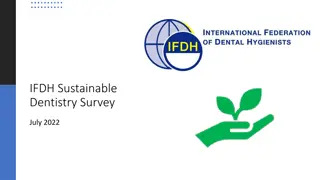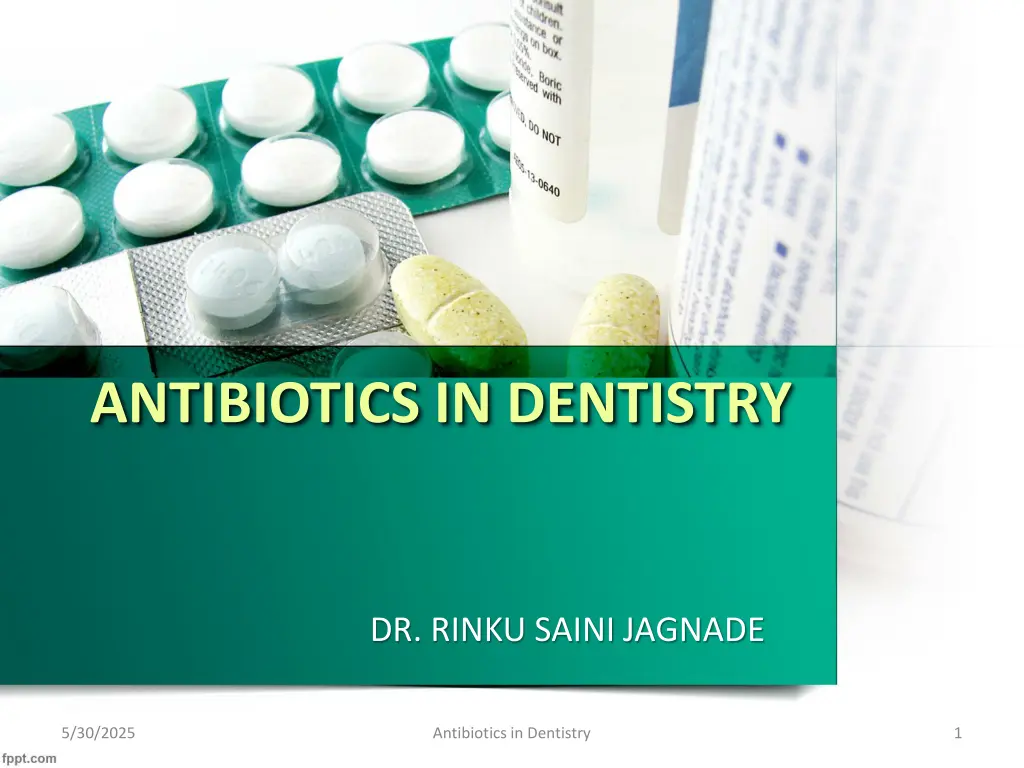
Understanding Antibiotics in Dentistry: History, Classification, and Clinical Use
Explore the fascinating history, classification, and clinical significance of antibiotics in dentistry. From Louis Pasteur's groundbreaking discoveries to modern-day applications, this comprehensive guide covers everything you need to know about how antibiotics are utilized in oral health care. Learn about different types of antibiotics, their chemical structures, and their role in treating orofacial infections. Discover the importance of antibiotic prophylaxis and potential drug interactions in dentistry. Stay informed and enhance your understanding of antibiotics in dental practice.
Download Presentation

Please find below an Image/Link to download the presentation.
The content on the website is provided AS IS for your information and personal use only. It may not be sold, licensed, or shared on other websites without obtaining consent from the author. If you encounter any issues during the download, it is possible that the publisher has removed the file from their server.
You are allowed to download the files provided on this website for personal or commercial use, subject to the condition that they are used lawfully. All files are the property of their respective owners.
The content on the website is provided AS IS for your information and personal use only. It may not be sold, licensed, or shared on other websites without obtaining consent from the author.
E N D
Presentation Transcript
ANTIBIOTICS IN DENTISTRY DR. RINKU SAINI JAGNADE 5/30/2025 Antibiotics in Dentistry 1
CONTENTS Introduction History Classification Antibiotics Useful For Orofacial Infections Problems that arises with use of antibiotics Combined use of antibiotics Antibiotic prophylaxis Clinically important drug interactions in dentistry Conclusions References 5/30/2025 Antibiotics in Dentistry 2
INTRODUCTION Substances produced by microorganisms, which selectively suppress the growth of or kill other microorganisms at very low concentrations. Commonly used in dental practice. 10% of all antibiotic prescriptions are related with dental infections. 5/30/2025 Antibiotics in Dentistry 3
HISTORY 1877:- Louis Pasteur postulated that bacteria could kill other bacteria (anthrax bacilli) 1929 :- Sir Alexander Fleming discovered the antibiotic substance penicillin from the fungus Penicillium notatum 1941:- Chain and Florey found out the clinical use of penicillin 1942:-Named antibiotics by Selman Waksman, an American microbiologist 1944 :- discovered streptomycin (Actinomycetes) Anti- fighting, opposing, or killing Bios- life(Greek) Literally means life-killing. 5/30/2025 Antibiotics in Dentistry 4
Classification of antibiotics A. Based on Chemical structure 1. Sulfonamides and related drugs: Sulfadiazine , Sulfones-Dapsone (DDS) 2. Diaminopyrimidines: Trimethoprim, Pyrimethamine. 3. Quinolones: Nalidixic acid, Norfloxacin, Ciprofloxacin 4. -lactam antibiotics: Penicillins, Cephalosporins, Monobactams, Carbapenems. 5. Tetracyclines: Oxytetracycline, Doxycycline, etc. 5/30/2025 Antibiotics in Dentistry 5
6. Nitrobenzene derivative: Chloramphenicol. 7. Aminoglycosides: Streptomycin, Gentamicin, Neomycin 8. Macrolide antibiotics: Erythromycin, Clarithromycin, Azithromycin, etc. 9. Lincosamide antibiotics: Lincomycin, Clindamycin. 10. Polypeptide antibiotics: Polymyxin-B, Colistin, Bacitracin, Tyrothricin. 11. Glycopeptides: Vancomycin, Teicoplanin 12. Oxazolidinone: Linezolid 5/30/2025 Antibiotics in Dentistry 6
13. Nitrofuran derivatives: Nitrofurantoin,Furazolidone. 14. Nitroimidazoles: Metronidazole, Tinidazole. 15. Nicotinic acid derivatives: Isoniazid, Pyrazinamide, Ethionamide. 16. Polyene antibiotics: Nystatin, Amphotericin-B, 17. Azole derivatives: Miconazole, Clotrimazole, Ketoconazole, Fluconazole. 18. Others: Rifampin, Spectinomycin, Cycloserine, Ethambutol, Thiacetazone, Clofazimine, Griseofulvin 5/30/2025 Antibiotics in Dentistry 7
B. Based on mechanism of actions 1. Inhibit cell wall synthesis: Penicillins, Cephalosporins, Cycloserine,Vancomycin, Bacitracin. 2. Cause leakage from cell membranes: Polypeptides Polymyxins, Colistin, Bacitracin. Polyenes Amphotericin B, Nystatin, Hamycin. 3. Inhibit protein synthesis: Tetracyclines, Chloramphenicol, Erythromycin, Clindamycin, Linezolid. 5/30/2025 Antibiotics in Dentistry 8
4. Cause misreading of m-RNA code and affect permeability: Aminoglycosides Streptomycin, Gentamicin 5. Inhibit DNA gyrase: Fluoroquinolones- Ciprofloxacin. 6. Interfere with DNA function: Rifampin, Metronidazole. 7. Interfere with DNA synthesis: Acyclovir, Zidovudine. 8. Interfere with intermediary metabolism: Sulfonamides, Sulfones, PAS, Trimethoprim, Pyrimethamine, Ethambutol. 5/30/2025 Antibiotics in Dentistry 9
C.Type of organisms against which primarily active 1. Antibacterial: Penicillins, Aminoglycosides, Erythromycin 2. Antifungal: Griseofulvin, Amphotericin B, Ketoconazole 3. Antiviral: Acyclovir, Amantadine, Zidovudine 4. Antiprotozoal: Chloroquine, Pyrimethamine, Metronidazole, Diloxanide 5. Anthelmintic: Mebendazole, Pyrantel, Niclosamide, Diethyl carbamazine 5/30/2025 Antibiotics in Dentistry 10
D. Spectrum of activity Narrow spectrum Penicillin G Streptomycin Erythromycin Broad spectrum Tetracyclines Chloramphenicol 5/30/2025 Antibiotics in Dentistry 11
E. Type of action Primarily bacteriostatic Sulfonamides Erythromycin Tetracyclines Ethambutol Chloramphenicol Clindamycin Primarily bactericidal Penicillins Cephalosporins Aminoglycosides Vancomycin Polypeptides Ciprofloxacin Rifampin Metronidazole Cotrimoxazole Linezolid 5/30/2025 Antibiotics in Dentistry 12
F. Antibiotics are obtained from: Actinomycetes Aminoglycosides Macrolides Tetracyclines Polyenes Chloramphenicol Fungi Penicillin Griseofulvin Cephalosporin Bacteria Polymyxin B Tyrothricin Colistin Aztreonam Bacitracin 5/30/2025 Antibiotics in Dentistry 13
Antibiotics Useful For Orofacial Infections: Penicillins. Cephalosporins. Erythromycins. Clindamycin Metronidazole. Aminoglycosides. Fluoro quinolones ciprofloxacin. Sulfonamides and trimethoprim 5/30/2025 Antibiotics in Dentistry 14
PENICILLINS Beta lactum antibiotics The drug of choice for the initial management of odontogenic infections remains penicillin CLASSIFICATION Natutal penicillins Penicillin G (Benzyl penicillin) Semisynthetic penicillin 1. Acid-resistant alternative to penicillin G Phenoxymethyl penicillin (Penicillin V). 5/30/2025 Antibiotics in Dentistry 15
2. Penicillinase-resistant penicillins: Methicillin, Cloxacillin. 3. Extended spectrum penicillins (a) Aminopenicillins: Ampicillin, Bacampicillin, Amoxicillin. (b) Carboxypenicillins: Carbenicillin, Ticarcillin. (c) Ureidopenicillins: Piperacillin, Mezlocillin. -lactamase inhibitors Clavulanic acid, Sulbactam Tazobactam 5/30/2025 Antibiotics in Dentistry 16
Mechanism of action Act by inhibiting cell wall synthesis in bacteria. Prevent sythesis & crosslinkage of peptidoglycans , the integral part of bacterial cell wall. Antibacterial spectrum of penicillin Effective mainly against gram +ve & gram ve cocci &and some gram +ve bacilli. 5/30/2025 Antibiotics in Dentistry 17
Adverse effect of penicillin Intolerance Thrombophlebitis Allergy with manifestation like 1.skin rash 2.serum sickness like syndrome 3.renal disturabane 4.haemopoitic disturabance 5.Anaphylaxis Superinfection e.g. candida Hypermia 5/30/2025 Antibiotics in Dentistry 18
Uses Dental infections Periodontal abscess Periapical abscess Pericoronitis Acute suppurative pulpitis ANUG Oral cellulitis Many oral pathogens acquired penicillin resistance. Use of PnG is very much restricted now. 5/30/2025 Antibiotics in Dentistry 19
PENICILLIN-G (BENZYL PENICILLIN) Narrow spectrum activity Limited primarily to gram-positive bacteria and few others. Streptococci except enterococci, Staph. aureus, N. gonorrhoea, N. meningitides, Anthracis, C.diphtheriae, Clostridia Penicillinase:- Production of penicillinase leads to acquired resistance, it opens the -lactam ring and inactivates PnG. 5/30/2025 Antibiotics in Dentistry 20
Dental infections Parenteral PnG- common infections (0.5 2 MU i.m. 6 hourly or 12 24) Streptococci, Peptostreptococci, Eubacterium Periodontal abscess, periapical abscess, pericoronitis, acute suppurative pulpitis, ANUG, oral cellulitis Acquired penicillin resistance very much restricted now. General medical uses Streptococcal infections: pharyngitis, tonsillitis Pneumococcal infections Meningococcal meningitis Gonorrhoea Syphilis 5/30/2025 Antibiotics in Dentistry 21
Phenoxymethyl penicillin (Penicillin V) Non serious dental infections and trench mouth For more serious infections Can t depend upon Streptococcal pharyngitis Sinusitis Otitis media Minor pneumococcal infections Dose: 250 500 mg, children 125 250 mg; given 6 hourly 5/30/2025 Antibiotics in Dentistry 22
Methicillin:- MRSA. Insensitive to cloxacillin and to other -lactams as well as to erythromycin, aminoglycosides and tetracyclines. Drug of choice- vancomycin/linezolid & ciprofloxacin Cloxacillin:- more active than methicillin against penicillinase producing Staph. Staphylococcal infections are rare in the oral cavity Cloxacillin is infrequently used in dentistry 5/30/2025 Antibiotics in Dentistry 23
Amino penicillins are one of the commonest antibiotics used in dentistry Ampicillin:-Active against all organisms sensitive to PnG H. influenzae, E. coli, Proteus, Salmonella and Shigella More active than PnG better suited for dental infections Dose: 0.5 2 g oral/i.m./i.v., every 6 hours; children 25 50 mg/kg/day. 5/30/2025 Antibiotics in Dentistry 24
Uses:- Urinary tract infections Respiratory tract infections Meningitis Gonorrhoea Typhoid fever Subacute bacterial endocarditis Orodental infections:- but diarrhoea limited its use 5/30/2025 Antibiotics in Dentistry 25
Amoxicillin is generally preferred Higher and more sustained blood levels and lower incidence of diarrhoea. Better absorbed orally Food does not interefere with its absorption Majority of cases resolve with 250 500 mg TDS given for 5 days First choice drug for prophylaxis of local wound infection and endocarditis following dental surgery 5/30/2025 Antibiotics in Dentistry 26
Carbenicillin Activity against Pseudomonas aeruginosa Infections caused by Pseudomonas or Proteus Burns, urinary tract infection, septicaemia Orodental infections rare by Pseudomonas; if at all they occur in immunocompromised patients 5/30/2025 Antibiotics in Dentistry 27
Clavulanic acid It has a -lactam ring No antibacterial activity of its own Addition of clavulanic acid re-establishes amoxicillin against Staph. aureus (not MRSA), Peptococcus, H. influenzae N. gonorrhoeae E. coli, Proteus Broaden antibacterial spectrum of amoxicillins Antibiotics in Dentistry 5/30/2025 28
Co-amoxiclav is indicated for Dental infections caused by -lactamase producing bacteria. Skin and soft tissue infections urinary, biliary and respiratory tract infections Amoxicillin 250 mg + clavulanic acid 125 mg tab; 1 2 tab TDS, severe infections 4 tabs 6 hourly. 5/30/2025 Antibiotics in Dentistry 29
CEPHALOSPORINS Semisynthetic antibiotics Obtained from a fungus Cephalosporium Chemically related to penicillins consists of a -lactam ring fused to a dihydrothiazine ring Inhibit bacterial cell wall synthesis similar to penicillin 5/30/2025 Antibiotics in Dentistry 30
First generation Second generation Third generation Fourth generation Parenteral Cefotaxim Cefriaxone Ceftizoxime Cefoperazone Parenteral Cephalothin Cefazolin Cephaloridine Parenteral Cefuroxim Cefoxitin Parenteral Cefepime Cefiperome Oral Cephalexin Cephadine Cefadroxil Oral Cefaclor Cefuroxim Axetal Oral Cefexim Cephpodoxime Cephdinir Ceftibuten 5/30/2025 Antibiotics in Dentistry 31
Adverse effects : Pain Diarrhoea Hypersensitivity Nephrotoxicity Neutropenia Thrombocytopenia Uses in Dentistry: Alternative to penicillin/amoxicillin(rashes or other milder allergic reactions) Acute gingival cellulitis responds rapidly 5/30/2025 Antibiotics in Dentistry 32
The 2nd generation compounds like cefuroxime axetil and cefaclor good activity against oral anaerobes preferred for dental indications. Cephalexin and cephadroxil are alternatives to amoxicillin - prophylaxis of local wound infection and bacterial endocarditis following dental surgery. 5/30/2025 Antibiotics in Dentistry 33
TETRACYCLINES Naphthalene derivatives Mechanism of action:- Interfer with protein synthesis by blocking the attachment of amino acyl transfer rna to acceptor site on m-RNA ribosome complex. Spectrum:- Includes both gram +ve & -ve orgamism 5/30/2025 Antibiotics in Dentistry 34
Tetracyclines Tetracycline Chlortetracycline Oxytetracycline Semi synthtic derivatives Doxycycline Demeclocycline Minocycline Methacycline Disadvantages Irritant property:- epigastric pain, nausea, vomiting and diarrhea Liver damage Diabetes insipidus Increased intracranial pressure Superinfection Kidney damage Phototoxicity 5/30/2025 Antibiotics in Dentistry 35
Teeth and bones Chelating property- Calcium-tetracycline chelate deposited in developing teeth and bone. Given from midpregnancy to 5 months of extrauterine life, the deciduous teeth affected- brown discolouration, ill-formed teeth, more susceptible to caries. Between 3 months and 6 years- affect the crown of permanent anterior dentition. Repeated courses- more damaging. Antibiotics in Dentistry 5/30/2025 36
Other Drugs That Cause Staining of Teeth Ciprofloxacin- a green color- mild than tetracycline staining. Minocycline hydrochloride- even after they are fully developed. 5/30/2025 Antibiotics in Dentistry 37
Uses Limited usefulness in treating acute dental infections Periodontitis: tetracycline 250mg qid/ doxicycline 20mg BD 2-4 wks Rickettsial infections Chlamidial infections Atypical pneumonia Cholera STDs Acne Protozoal infections 5/30/2025 Antibiotics in Dentistry 38
Precautions 1. should not be used during pregnancy, lactation and in children. 2. should be avoided in patients on diuretics: blood urea may rise 3. should be used cautiously in renal or hepatic insufficiency. 4. expiry date. 5. Do not mix injectable tetracyclines with penicillin inactivation occurs. 5/30/2025 Antibiotics in Dentistry 39
AMINOGLYCOSIDES Mechanism of action Combine with the bacterial ribosomes & interferes with m-RNA ribosomes combination which ultimately prevents protien synthesis Soil actinomycets:- streptomycin, kanamycin, tobramycin, neomycin Semisynthetic:- Amikacin, Netilmicin 5/30/2025 Antibiotics in Dentistry 40
Toxicities Ototoxicity Nephrotoxicity Neuromuscular blockade Gentamicin Broad spectrum action compared to Use Only application in dentistry- gentamicin 2 mg/kg i.m./i.v. (single dose) to supplement amoxicillin or vancomycin for prophylaxis of bacterial endocarditis following dental surgery in patients with prosthetic heart valves 5/30/2025 Antibiotics in Dentistry 41
ERYTHROMYCIN Isolated from Streptomyces erythreus Used as alternative in penicillin sensitive individuals Mechanism of Action Binds to 50s ribosomes and inhibits bacterial protein synthesis. Contra indications Hypersensiivity Liver dieases 5/30/2025 Antibiotics in Dentistry 42
Available as tablet & syrup Dose Adult-250-500mg QID,Children-30-50mg kg/day Adverse reaction Hepatitis Epigastric distress Allergic reactions Diahrroea Hypertention Cardiac arrhythmias Revesible hearing loss 5/30/2025 Antibiotics in Dentistry 43
Uses Orodental infections:- post extraction infections, periapical abcesses and infected periodontal lesions. Pneumonia Streptococcal infections Staph. Infections Syphilis Anthrax Diphtheria Tetanus Skin infections 5/30/2025 Antibiotics in Dentistry 44
Clarithromycin Component of triple regimen for H. pylori infections in peptic ulcer patients Azithromycin Azalide derivative Free of drug interactions Respiratory, Genital and Skin infections Clindamycin Reserve drug - penicillin or a macrolide can t given or no response Good penetration into bone- dentoalveolar abscesses and other bone infections Antibiotic prophylaxis against bacterial endocarditis in oral procedures Antibiotics in Dentistry 5/30/2025 45
Metronidazole Nitroimidazole Active against anaerobes Mechanism of action This binds to DNA and prevents formation of nuclic acid Contraindications Neurogenic diseases Blood dyscrasias first trimester of pregnancy 5/30/2025 Antibiotics in Dentistry 46
Uses Orodental infections ANUG- often combined with either penicillin V, amoxicillin, erythromycin or tetracycline Periodontitis Pericoronitis Acute apical infections Endodontic infections Amoebiasis H. pylori infections 5/30/2025 Antibiotics in Dentistry 47
Dose Orally 400mg 8hrly IV infusion 0.5gms/8hrs. Treatment should be continue for 7 days. Adverse effects Anorexia Nausea Metalic taste Headache Glossitis Dryness of mouth Thromphlebitis of injected veins 5/30/2025 Antibiotics in Dentistry 48
Ciprofloxacin Most potent and active against aerobic gram-negative bacilli Fewer side effects Pseudomonas rare Combined with metronidazole for periodontitis. UTI, Typhoid Ofloxacin, gatifloxacin and moxifloxacin- more active against grampositive bacteria and anaerobes,utility in dentistry. 5/30/2025 Antibiotics in Dentistry 49
COTRIMOXAZOLE Trimethoprim and sulfamethoxazole Combination- cidal against many organisms Preparations 80 mg + 400 mg tab 160mg + 800 mg tab: double strength Uses UTI Respiratory tract infections Typhoid Bacterial gastroenteritis Chancroid Mild Orodental infections 5/30/2025 Antibiotics in Dentistry 50

